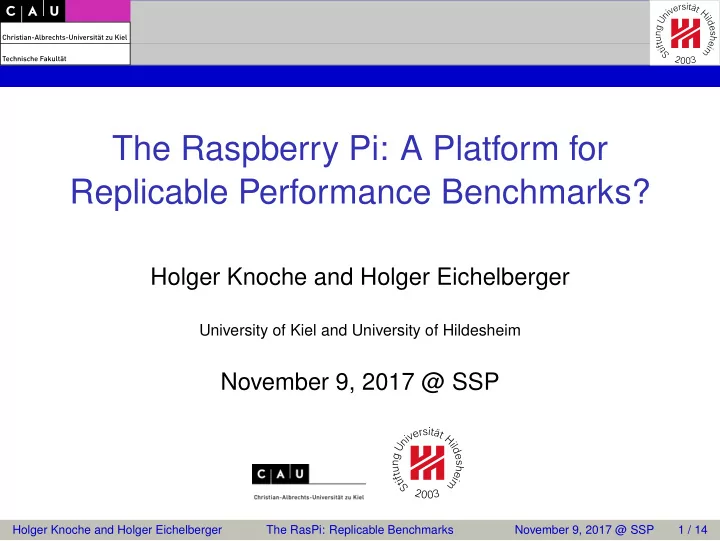

The Raspberry Pi: A Platform for Replicable Performance Benchmarks? Holger Knoche and Holger Eichelberger University of Kiel and University of Hildesheim November 9, 2017 @ SSP Holger Knoche and Holger Eichelberger The RasPi: Replicable Benchmarks November 9, 2017 @ SSP 1 / 14
Agenda 1. Introduction 2. Approach 3. Experimental Results 4. Conclusions Holger Knoche and Holger Eichelberger The RasPi: Replicable Benchmarks November 9, 2017 @ SSP 2 / 14
Motivation Introduction Replicability is a fundamental property of scientific experiments. But: Replicating performance benchmarks is difficult. Major reason: Researchers use the hardware and software environment that happens to be available to them. Holger Knoche and Holger Eichelberger The RasPi: Replicable Benchmarks November 9, 2017 @ SSP 3 / 14
Research Question Introduction Can the use of cheap, standardized hardware like the Raspberry Pi improve the replicability of performance benchmarks? Running example: MooBench Holger Knoche and Holger Eichelberger The RasPi: Replicable Benchmarks November 9, 2017 @ SSP 4 / 14
Terminology – Ilities Introduction Repeatability The ability of an experiment to be repeated by the same researcher within a short period of time Replicability The ability of an experiment to be repeated by other researchers with consistent results Reproducibility The ability of aggregated results to be reproduced / recalculated by other researchers Holger Knoche and Holger Eichelberger The RasPi: Replicable Benchmarks November 9, 2017 @ SSP 5 / 14
The Raspberry Pi Introduction ◮ Credit card-sized single-board computer ◮ Originally conceived as an affordable tool to learn programming ◮ First models released in 2012 ◮ Current model (Raspberry Pi 3, 2016) has a quad-core 64-bit ARM processor at 1.2 GHz and 1 GB RAM ◮ Uses MicroSDHC cards as primary storage ◮ Retail price around 40 C ◮ All models are still available for purchase ◮ Default OS is a Debian-based Linux distribution (Raspbian) Holger Knoche and Holger Eichelberger The RasPi: Replicable Benchmarks November 9, 2017 @ SSP 6 / 14
Overall Approach Approach We... 1. ...bought three Raspberry Pi 3 devices ◮ Two from the same retailer within two weeks as a set with an SD card and a power supply ◮ One from another retailer a few months later 2. ...created a master SD card image ◮ Based on Raspbian Jessie Lite ◮ Included Oracle JDK (provides JIT compiler) and everything required to run the benchmarks 3. ...shared the master image among the authors 4. ...ran the preconfigured benchmarks on the devices Holger Knoche and Holger Eichelberger The RasPi: Replicable Benchmarks November 9, 2017 @ SSP 7 / 14
Setup for MooBench Approach ◮ Current version from GitLab as of August, 2017 ◮ Setup for Kieker ◮ Version 1.11 (included in MooBench package) ◮ Modified MooBench configuration due to storage limitations (1M invocations, recursion depth 5, 10 iterations) ◮ Setup for SPASS-Meter ◮ Version 1.21 (re-compiled native library for ARM) ◮ Default MooBench configuration (2M invocations, recursion depth 10, 10 iterations) Holger Knoche and Holger Eichelberger The RasPi: Replicable Benchmarks November 9, 2017 @ SSP 8 / 14
Kieker Experimental Results ◮ Resource monitoring, persist data as fast as possible ◮ Results: Similar for all devices ◮ Initial: extreme response time fluctuations ◮ USB-HD: Mean response time -79%, σ -96% ◮ Class-10 SD: Mean response time -50% Holger Knoche and Holger Eichelberger The RasPi: Replicable Benchmarks November 9, 2017 @ SSP 9 / 14
SPASS-Meter Experimental Results ◮ Resource monitoring, online analysis ◮ Results: Similar for all devices ◮ Around 160 µ s response time ◮ Slight response time increase, two “humps“ ◮ USB-HD: Mean response time -6%, σ -87% Holger Knoche and Holger Eichelberger The RasPi: Replicable Benchmarks November 9, 2017 @ SSP 10 / 14
Descriptive Statistics Experimental Results ◮ Data: Stable state raw time series ◮ Baseline: Very similar for all devices ◮ SPASS-meter: ◮ ∆ response time < 32 µ s ◮ 10% of server results [SSP ‘16] ◮ Kieker: ◮ ∆ response time < 55 µ s, better with HD ◮ But... high deviations D1 D2 D3 95% CI 95% CI 95% CI σ σ σ Baseline [1.6;1.6] 0.2 [1.6;1.6] 0.8 [1.6;1.6] 0.3 SPASS / SD [180.3; 180.4] 45.8 [148.8;148.9] 45.1 [159.0;159.0] 39.7 SPASS / HD [164.8; 164.8] 44.1 [156.4;156.4] 46.4 [164.8;164.8] 43.9 Kieker / SD [555.0;684.5] 73,893.1 [498.7;635.1] 77,779.6 [504.8;642.1] 78,353.5 Kieker / HD [120.8;126.4] 3,193.7 [109.6;114.2] 2,612.1 [110.8;115.7] 2,809.4 Holger Knoche and Holger Eichelberger The RasPi: Replicable Benchmarks November 9, 2017 @ SSP 11 / 14
Variances? Experimental Results ◮ High variance, but aggregated graphs look smooth? ◮ Raw data does not ◮ No such variances in [SSP’16] data 1000 Mean response time of ... SPASSmeter ASM No instrumentation SPASSmeter Javassist 800 Mean response time ( µ s) 600 400 200 0 0 500000 1000000 1500000 2000000 Number of method executions ◮ Recent results: It’s not the Pi! Holger Knoche and Holger Eichelberger The RasPi: Replicable Benchmarks November 9, 2017 @ SSP 12 / 14
Summary Conclusions ◮ Replicating performance experiments is difficult ◮ Good replication support on Pi ◮ Straightforward setup ◮ Brief experiment specification ◮ Faster storage reduces deviations, needs but additional specification ◮ Similar results across devices, including “humps“ ◮ High deviations, but it’s not the Pi! Holger Knoche and Holger Eichelberger The RasPi: Replicable Benchmarks November 9, 2017 @ SSP 13 / 14
Future work Conclusions ◮ Deviations: More experiments... ◮ Next Pi: More resources? ◮ Package experiments, e.g., Docker Holger Knoche and Holger Eichelberger The RasPi: Replicable Benchmarks November 9, 2017 @ SSP 14 / 14
Recommend
More recommend